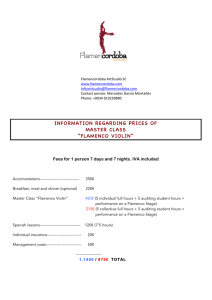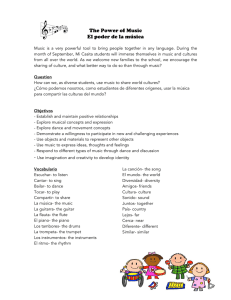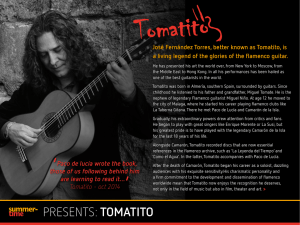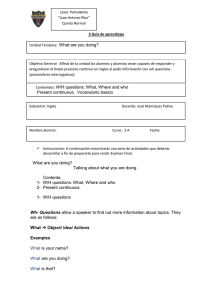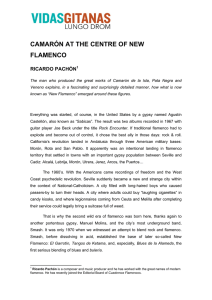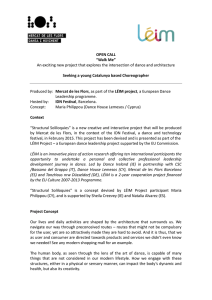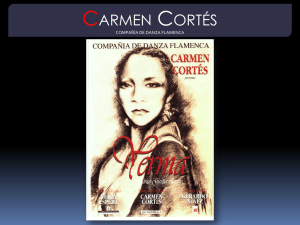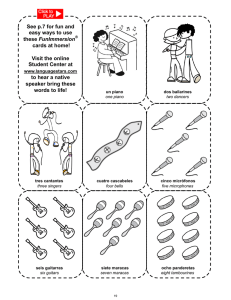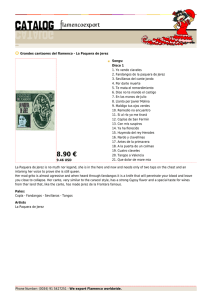The flamenco dance in the cafés cantantes epoch
Anuncio
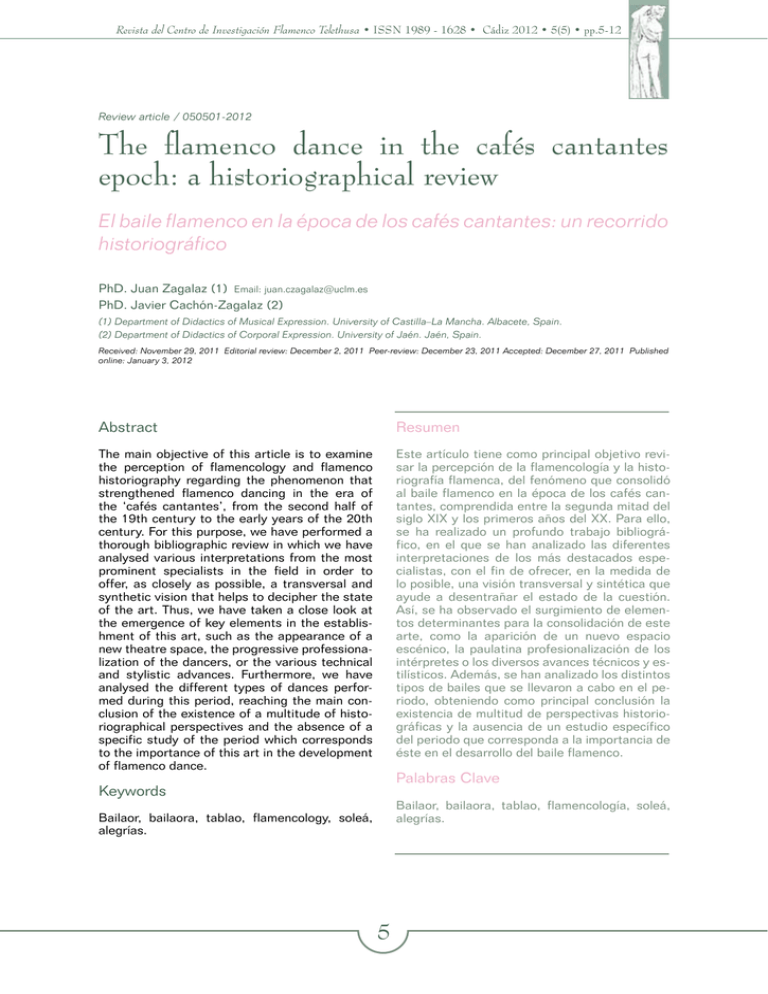
Revista del Centro de Investigación Flamenco Telethusa • ISSN 1989 - 1628 • Cádiz 2012 • 5(5) • pp.5-12 Review article / 050501-2012 The flamenco dance in the cafés cantantes epoch: a historiographical review El baile flamenco en la época de los cafés cantantes: un recorrido historiográfico PhD. Juan Zagalaz (1) Email: juan.czagalaz@uclm.es PhD. Javier Cachón-Zagalaz (2) (1) Department of Didactics of Musical Expression. University of Castilla–La Mancha. Albacete, Spain. (2) Department of Didactics of Corporal Expression. University of Jaén. Jaén, Spain. Received: November 29, 2011 Editorial review: December 2, 2011 Peer-review: December 23, 2011 Accepted: December 27, 2011 Published online: January 3, 2012 Abstract Resumen The main objective of this article is to examine the perception of flamencology and flamenco historiography regarding the phenomenon that strengthened flamenco dancing in the era of the ‘cafés cantantes’, from the second half of the 19th century to the early years of the 20th century. For this purpose, we have performed a thorough bibliographic review in which we have analysed various interpretations from the most prominent specialists in the field in order to offer, as closely as possible, a transversal and synthetic vision that helps to decipher the state of the art. Thus, we have taken a close look at the emergence of key elements in the establishment of this art, such as the appearance of a new theatre space, the progressive professionalization of the dancers, or the various technical and stylistic advances. Furthermore, we have analysed the different types of dances performed during this period, reaching the main conclusion of the existence of a multitude of historiographical perspectives and the absence of a specific study of the period which corresponds to the importance of this art in the development of flamenco dance. Este artículo tiene como principal objetivo revisar la percepción de la flamencología y la historiografía flamenca, del fenómeno que consolidó al baile flamenco en la época de los cafés cantantes, comprendida entre la segunda mitad del siglo XIX y los primeros años del XX. Para ello, se ha realizado un profundo trabajo bibliográfico, en el que se han analizado las diferentes interpretaciones de los más destacados especialistas, con el fin de ofrecer, en la medida de lo posible, una visión transversal y sintética que ayude a desentrañar el estado de la cuestión. Así, se ha observado el surgimiento de elementos determinantes para la consolidación de este arte, como la aparición de un nuevo espacio escénico, la paulatina profesionalización de los intérpretes o los diversos avances técnicos y estilísticos. Además, se han analizado los distintos tipos de bailes que se llevaron a cabo en el periodo, obteniendo como principal conclusión la existencia de multitud de perspectivas historiográficas y la ausencia de un estudio específico del periodo que corresponda a la importancia de éste en el desarrollo del baile flamenco. Palabras Clave Keywords Bailaor, bailaora, tablao, flamencología, soleá, alegrías. Bailaor, bailaora, tablao, flamencology, soleá, alegrías. 5 las amplitudes articulares y acortamientos musculares en TheValoración flamencodedance in the cafés cantantes epoch: a historiographical review bailaoras de flamenco Zagalaz J, Cach J González A, Gómez R, Fernández J, Costa JL Rev Cent Investig Flamenco Telethusa 2012 • 5(5)• pp.5-12 Introduction Flamenco dance in the ‘cafés cantantes’ era: a historiographical review In recent years, flamencology has made marked advancements with the proliferation of regulated studies and the consequent emergence of new means of transmission and research. Even so, the historical category of flamenco as one of the most developed and characteristic national artistic representations of the entire European spectrum requires a more in-depth study that highlights its outstanding attributes. The constant difficulty stemming from the study of both corporal and musical artistic expressions is perfectly well-known, particularly those from specific historical periods that solely provide us with graphic representations, direct and indirect mentions, or less-specific iconographic and literary material. While in other artistic domains, such as painting, sculpture or architecture, we possess artistic fact in itself, in music and dance, up until the appearance of video and techniques for recording and mechanical reproduction, we only retain visual and textual representations: individual perspectives to narrate a dynamic and changing reality. Is it possible to reconstruct expressions of music or dance exclusively through writings, testimonies and graphic, pictorial or photographic representations? Can one tell the history of dance and music? Can flamenco fact be passed on solely with words? Martínez’s1 work is one of the most complete and most focused on dance, and it retains much of its relevance despite originally having been published in 1969. The author rigorously goes deep into the universe of flamenco dancing in a well-organized fashion, in a practical dealing which has an interesting and complete opening section dedicated to its origin and historical evolution. It divides the history of flamenco dance into three phases, the second stage being the one which corresponds to the ‘cafés cantantes’. This section outlines a brief historical context that makes the importance of this time period evident, in which the styles are set, the rhythm is disciplined and the rules that will have to last more-or-less undistorted until our time are forged1 (p. 28). The section dedicated to technical documentation in regards to dance is particularly useful. Therein, the author divides the prominent stylistic parameters in flamenco dancing that were produced during the ‘cafés cantantes’ era into five points. The constant references to this work in the historiography of the dance, as we will see below, position it as one of the central works when being introduced to the world of flamenco dancing, both on a theoretical-historical plane as well as on a practical and performative plane. When recreating these types of representations, the accuracy will vary depending on the information available. This is what flamencology has produced in order to narrate the state of flamenco during its consolidation in the nineteenth century. Therefore, different specialists have made a great effort in that reconstruction, basing it on the existing sources, which though not exactly scarce, aren’t as numerous as one would like, either. This article attempts to examine the reflection of dance in flamenco historiography, dominated by the Andalusian folk song, during the ‘cafés cantantes’ period, dated between the last third of the 19th century and the first years of the 20th century. In order to do that, we’ve analysed the most prominent historical literature on flamenco, from books dedicated to general history to those dedicated specifically to dance, as well as practical or theoretical -practical manuals. The comparative study of flamenco has given a current perspective of the most important time period in the consolidation of flamenco dance, from the ‘café’ flamenco bars to the professionalization, stylisation and artistic independence of its origins: the guitar and the folk song. Martínez, more recently, wrote an interesting chapter2 in which she stresses the importance of the academies in consolidating flamenco dance, placing great relevance on the appearance of a characteristic theatre space, the ‘cafés cantantes’, where the professionalism of the dance would be produced. Moreover, she highlights the analytical ability of the maestros of the dance, who perceived the capacity of flamenco to attract society and remove the expressive tricks and variants that the gypsies attached to existing popular dances. Álvarez3 makes an in-depth analysis based on historical documents of varying types. The author delves into the origins of the ‘cafés cantantes’ in a descriptive tone, constantly inserting contemporary sources into the playful and rowdy atmosphere of these establishments, as observed in the words of the Nicaraguan poet Rubén Darío included in his work: After they’ve danced, the female bolero and flamenco dancers come down to visit the consumers at their tables, to make them spend as much as they can, at the orders 6 of the café’s owner […] From table to table pouring manzanilla and more manzanilla, from table to table where there are foreigners and visitors, because the locals know the game and don’t allow themselves to be exploited. (p. 57)3 to Estébanez Calderón. From this to the ‘cafés cantantes’ and from these to the theatre, without significant clarifications. (p. 217) 5 Manfredi6, another classic flamenco historian, succinctly mentions dancing, although his work is much more focused on flamenco singing. According to his vision, the gradual separation of song and dance has been verified, between the 19th and 20th centuries, based on the idea that initially the singer was the centrepiece and that nowadays it seems like the song is on a second plane, only there as an accompaniment. Thus, he states that dancing has invaded the forbidden territories of folk singing and acknowledges that some dancers have taken the ‘soleá’ to peaks as high as those reached by the masters of the folk song. (p. 152)6 Thus, the surface on which flamenco dance ended up strengthening itself is demystified, although there are no specific mentions of the dance made until the chapter titled The dance evolves, which focuses on the role played by these local patrons in the direct development of the dance. The final result is a genuine and historically verified vision in which many aspects relating to the general history of flamenco dance are clarified. For his part, Navarro4 performs an excellent analysis of the historical development of the dance in Andalusia since Roman times with the known exponent of Telethusa. Starting with the twenty-sixth chapter, he focuses his attention on the birth of flamenco dance, setting the date of 1865 as the moment when those dances are the undisputed focal point of Sevillian parlours. In the following chapters, he stresses the conflictive night life environment of these establishments, as well as the different dances and figures of this period, detailing through the different available sources he performances and the role of the different performers of the period, which makes it an essential document for discerning the reality of dance during the era at hand. Caballero7 offers a general perspective of the dances in Andalusia, amongst which is flamenco dance. Specifically, it is worth highlighting the distinction between what he considers to be ‘jondo’ and what he considers to be ‘flamenco’. The author links both to singing, maintaining that there is no […] systematic relationship between the songs and the dances included in this denomination of ‘jondo’ (p. 25)7. He explains that the first jondo songs were not implicitly accompanied by dance at its beginnings, while when discussing flamenco, the author describes it in a clearly derogatory tone as a result borne out of jondo, in a certain sense diluted by commercialisation: Amongst the most prominent specialists in flamenco historiography, it’s necessary to point out the figure of Blas5, who examines diverse themes relating to research in flamenco. The chapter dedicated to the cafés cantantes is very interesting, as well as the chapter titled Hacia la historia del baile flamenco (Towards the history of flamenco dance), in which he traces the most important lines of the historic development of the dance, explicitly expressing the current state of research to this respect: Flamenco dance is grouped under the shelter of “jondo” dancing [...] All of the dances that are now named “chuflas” (after jokes) are nothing more than twisted manifestations of the ‘jondo’, as they’ve been taken away from their intrinsic seriousness and grandeur and placed within the reach of tourism and the commercial stage. (p. 30)7 We also find this division between jondo and flamenco in the work of Carretero8, who states that the profound mark of all of the cultures that Andalusia welcomed can be found in “jondo” (p. 48)8. She maintains that in the 19th century, the cafés cantantes collaborated to the spreading of “jondo” song and dance (p. 53-54)8, although she clearly indicates the difference, noting that two types of show exist: one of a more festive character and another performed with greater sobriety, jondo. When classifying flamenco dance, the historian finds himself with a complicated labyrinth of information and interpretations [...] The existing documentation is rather chaotic and not very enlightening, and those who have tried to study the phenomenon of flamenco dance find themselves with a clear contradiction of dates, hierarchies and technicalities [...] Theorists salvage the situation by making great historical leaps, from the 18th century “bolero” 7 Zagalaz J, Cach J The flamenco dance in the cafés cantantes epoch: a historiographical review Rev Cent Investig Flamenco Telethusa 2012 • 5(5) • pp. 5-12 las amplitudes articulares y acortamientos musculares en TheValoración flamencodedance in the cafés cantantes epoch: a historiographical review bailaoras de flamenco Zagalaz J, Cach J González A, Gómez R, Fernández J, Costa JL Rev Cent Investig Flamenco Telethusa 2012 • 5(5)• pp.5-12 The chapter titled El baile en los cafés cantantes (Dancing in the cafés cantantes), by Casado9, must also be mentioned. Therein, the author outlines the transition from dance in the academies and parlours to the cafés cantantes and dedicates a large section to the evolution of dance during that period. He uses information that textually exhibits the information and strings it together relevantly and truthfully, which makes it one of the texts most focused on the subject of this article. Caballero7 refers to the time of the cafés cantantes as the era when the first figures appeared who knew how to bring together the fabulous legacies of our rhythmic primogenitures with the purest and oddest understanding (p. 63)7. Even when Navarro4 reminds us that not all shows that took place in the cafés cantantes were flamenco, the importance of these locales is clearly observed in the progressive professionalization of the group. Álvarez3 maintains that during this period, of the three pillars of flamenco, dancing is the one that benefitted the most, amongst other factors due to the type of stage, which required a more spectacular offering [...] than the singer and the guitarist both seated in chairs without any type of accompaniment (p. 73)3. It’s not difficult to imagine the dynamism and energy displayed by the dance, with its thunderous, masculine foot stamping resonating all over the locale and the suggestive feminine movements in the frenzied and drunken context described in the various sources. Casado9 stresses that one of the most important innovations is the appearance of a new stage space, the platform, on which the foot tapping reaches a greater resonance, and consequently the foot play and tapping begins to get more sophisticated to the points of true virtuosity (p. 258)9. Grande10 also expresses himself in this sense, strengthening the idea of the visual show offered by Álvarez3, as well as the easier connection with the average attendee through purely visual and human aspects. Navarro4 notes that the dances scarcely lasted a few minutes, during which the performer had to win over the audience, following certain parameters but at the same time being original and personal, in order to differentiate themselves from their various competitors. This, together with the descriptions made by Álvarez3 regarding the prevailing atmosphere in the cafés cantantes, allows us to visualize the tough competition between the performers. Dance in the Cafés Cantantes and the professionalization thereo There is no doubt about the decisive role of the cafés cantantes in the development of the flamenco art when you take into account its constant presence in the writings of different specialists. Martínez highlights the central importance of this period in the general development of flamenco, in which the specialisation of the public and competition add new aesthetic perspectives, refining the form without losing the value of spontaneous creation (p. 28)1, agreeing with Grande, who states in his work Memory of Flamenco, that the dance expands its forms and enriches its catalogue of expressive variants (p. 244)10. This balance between an incipient professionalization, the proximity of a certain stylistic authenticity, the decisive role of the interpretative space, the education of the public and the competition between the different artists, converge in a gradual and well-proportioned growth of the dance. Therefore, Blas affirms that the most suitable and feasible formula for watching and listening to flamenco was possibly in the “café cantante”(p. 27)5. Navarro also expresses himself in these terms, as he asserts that the cafés cantantes provided the crystallisation and definitive codification of flamenco dance (p. 277)4. Grande10 reinforces the idea of the liberalisation of the dance during this period, as does Álvarez3, who considers the role of the ‘cafés cantantes’ to be unquestionable in the evolution of the flamenco art, and singularly, in dance: All of the information gathered and analysed by specialists unequivocally leads to the concept of professionalization. In the case of flamenco, the main stage where this manifests itself is the café cantante5, and despite, according to Álvarez3, the dancing being around 50 years behind the singing in terms of professionalization, this period was decisive for its consolidation, as we can observe from the words of Martínez: From the domestic circles, the village dances and even the academies […] to a public space expressly created for the exhibition of shows, a noticeable transformation occurred, demanded basically because now there was a stage, or a platform, which has a much more structured organization. The flamenco scene, we could say, is institutionalised. (p. 69)3 This sudden flourishing of flamenco marks a new period in its evolution, perhaps its most important and decisive, because now it is defined as a spectacular and professional dance. (p. 28).1 8 Navarro4 also highlights the huge importance of the cafés cantantes in the professionalization of the flamenco art, stating that thanks to them, flamenco artists were able to turn professional and inside the cafés, in short, the first figures who write the opening pages of the history of this art gained fame and renown (p. 277)4. Although Navarro doesn’t distinguish between dancing and singing, and Ríos11 reminds us that the history of flamenco dancing runs parallel to singing, Álvarez3 maintains that it was in the cafés where singing gained independence from dancing and where dancing became majestic and reached the plastic beauty that today is one of its most characteristic attributes. (p. 287)3 while others sacrifice these skills in pursuit of controlling the artistic-expressive content. This division also refers to the absence of castanets in the dance. According to Blas5, the bata de cola, a flamenco dress with a train, appeared with the cafés cantantes, creating a new aesthetic, also adding the shawl and the wide-brimmed hat. Martínez1 also mentions the introduction of the bata, as well as the immobility of the skirt, which hardly lifts off the ground, arguments which are repeated almost identically in the work of Gamboa12. In both writings, the absence of violent movements in the female dance is mentioned, an idea reinforced by Casado in stating that the ”bata de cola” forces the female dancer to reduce her movements and create a more intimate and introspective way of dancing. (p. 259)9 Certain homogeneity is observed in the different sources in determining the cafés cantantes to be a central element in the development of flamenco, in general, and as an ideal cultural medium for the stylisation and professionalism of the dance. Furthermore, the gradual consolidation of the flamenco show in the cafés is extracted, as is the progressive separation of song and dance, in addition to the definition of an extremely favourable stage space, the platform. This relative consensus, beyond the nuances introduced by each author, is fragmented when the most specific parameters are analysed, as we will see below. The final point that Martínez1 explicitly deals with is one of the characteristics most highly emphasized by the researchers: the role played by men and women in this stage of development of the flamenco dance. In this section, she refers to the even greater differentiation, compared to the previous time period, between male and female dancing. In the female’s case, the focus became their arms and their heads, while for males the dance introduced greater mobility in their feet. Gamboa writes that women, as opposed to the masculine foot tapping, show off from their midsection on up (p. 322)12, although he points out the appearance of the first female dancers dressed as men, who also use their legs as the central element, despite not being considered amongst the biggest purists of the era. We find similar arguments in the work of José Otero, who states that “La Cuenca” [...] danced dressed as a man with shorts and ankle boots (p. 155)13. There are also opposite examples, although less numerous, in which it is the man who dresses like a woman, as highlighted by Casado, who mentions Pepe el de la Matrona, referring to the dancer Félix el Mulato, who performed dressed as a woman, with a “bata de cola”, dancing very well (p. 259)9. Navarro4 also joins this argumentative thread, emphasizing the differentiation of male and female dancing in this time period, although he goes into even greater detail in differentiating between the dress and pants: Stylistic and formal changes. Types of dances Regarding stylistic analysis, characteristics and types of dances, we find more varied information. We start with the idea offered by Ríos, who maintains that the main thing about flamenco dance is its accompaniment to the guitar, since it is the instrument that most suitably keeps the time, with its special sound, without which flamenco wouldn’t make any sense (p. 211)11. According to Navarro4, very significant changes were made in Andalusian dance during the1860s, when flamenco dance was now a reality. Also, starting in 1865, so-called flamenco dances acquired a central role in the shows performed in Sevillian saloons. Martínez1, for her part, in the first two points of the five in which she outlines the characteristics of the dance during this period, speaks of the evolution and precision in the stylistic and rhythmic parameters, whereas the third centres on the development of technique. The author holds that the artists cannot command all aspects of the dance, so they specialise in several of them, The female dance was from the waist up: gracefulness in the figure, expressiveness in the face, movement in the hips, swaying movements, hardly any heel clacking, and movements of the arms and hands. The male dance was austere, restrained, with an upright 9 Zagalaz J, Cach J The flamenco dance in the cafés cantantes epoch: a historiographical review Rev Cent Investig Flamenco Telethusa 2012 • 5(5) • pp. 5-12 las amplitudes articulares y acortamientos musculares en TheValoración flamencodedance in the cafés cantantes epoch: a historiographical review bailaoras de flamenco Zagalaz J, Cach J González A, Gómez R, Fernández J, Costa JL Rev Cent Investig Flamenco Telethusa 2012 • 5(5)• pp.5-12 figure, and was focused on the waist down, in search of personal skills in the virtuosity of his foot stomping. (p. 289)4 We also find these arguments in the work of Blas5, who similarly makes a note of the differentiation between man and woman, highlighting the expressivity from the waist up in the case of women, and the search of boastful execution in foot movements in the case of men. Pablo and Navarro14 emphasize this aspect, specifying that the alegrías, the soleá and the tientos were feminine dances, while the zapateado and the farruca were masculine. We also find a certain reflection of the man/ woman proportion amongst the professionals of the dance during this era. Grande10 affirms that there were many more female dancers than male dancers, while Martínez1 specifies an even larger discrepancy, stating that the proportion was approximately one male dancer to every twenty female dancers, since men were more engaged in singing and playing the guitar. On another front, but none less important, is the assertion made by Gamboa12, who reminds us of the clear economic discrimination suffered by women with respect to men, in the words of Rafael Pareja, included in his text: Rafael Pareja would recall that around 1893 “Chacón was the highest earning artist (30 pesetas), followed by Juan Breva (25.). [...] Women had a much lower salary! ‘La Macarrona’ was the best paid, at 12 pesetas, but the rest earned much less than men”. (p. 323)12 The relative consensus that we find referring to the differentiation of the role played by men and women, unfortunately also reflected in their perceived salaries, does not find consistency regarding the types of dances they performed or what role they played in the ‘cafés cantantes’. In this sense, various authors1,4,11 systematically specify which dances were the most prominent of each time period, while other authors do not feature such schematic and precise lists: Tabla 1: Dances specified by some of the main authors. Author Dances specified Zapateado Martínez1 Alegrías Farruca Tango Garrotín Martínez1 Soleares Tientos Alegrías Navarro4 Tangos Soleares Zapateado Fandangos Ríos11 Tangos Soleares Alegrías Martínez1 states that tango, a common denominator in most of the writings, was spread more in relation to the previous time period, defining it as a women’s dance that required lots of grace, picaresque expressions and agile contortions, at a marked and catchy rhythm (p. 31)1. She alludes to the figures of Concha La Carbonera and Rafaela Valverde to show that they themselves provided the folk song accompaniment at the same time. Álvarez3 goes further than that, affirming that tango was the most popular dance in flamenco environments, highlighting its erotic character, alluding to the words of Otero. Casado10 expressed himself in the same vein, stating that tango was the most fashionable dance, while in turn emphasizing craftiness, femininity and the use of shawls and wide-brimmed hats. Navarro4, for his part, stresses tangos as a required dance in the cafés cantantes at the end of the 19th century, it being the festive dance par excellence. Blas5 also highlights the dance, saying that starting in the 1880s, the popularity of tango prevailed, along with the tanguillo, the milonga and the tiento. Otero13 also alludes to the tango, although from a more practical perspective and, in a certain way, biased, although he catalogues it as flamenco dance, just like the farruca and the garrotín. It is not the only source in which both the farruca and the garrotín are associated with tango. As regards the farruca, Martínez1 defines it as a dance full of gravity and stillness (p. 31), 10 highlighting the drumming of the feet, implying its greater presence in the male community, along the line put forth by Caballero7, who speaks of a dance tinged with seriousness, melancholy and static, rhythmical and solemn (p. 45). Carretero8 stresses its character foreign to Andalusia, specifically connecting it to the Cadiz tango. Martínez1 mentions Faíco el Viejo as the creator of the ‘farrucas’, while Caballero7 associates them with both Faíco and El Gato, clarifying that they have a tango beat. Otero13 backs these ideas, linking the farruca to the garrotín and the tango, and connecting the success of these dances to those harvested by Faíco for performing and internationalising them. Even though he attributes their popularisation directly to Faíco, he maintains that people had been dancing them along the southern coast of Spain for two decades. Ríos11 also grants the creation of the farruca dance to Faíco, together with the guitarist Ramón Montoya, although regarding the garrotín he solely involves him in its rebirth. Blas5 dates the peak of both the farruca and the garrotín, amongst other dances, at the beginning of the 20th century, by imposing new formulas that will connect with the world of “cuple” (variety song) and variety shows. (p. 35)5 The other great dance constantly present in most of the works is the alegría. Vallecillo (1984), in the article Las Cantiñas y sus derivaciones, published in issue 36 of the magazine Candil in 1984 and quoted in the work of Pineda15, suggests its birth around 1850 at the hands of José Gimenez, El Granaíno. Navarro4 categorises it as a key dance in the cafés cantantes at the end of the 19th century, describing it as a festive, fresh and spontaneous dance, in which gracefulness was the basic pillar, additionally including singing by the female dancers who performed it. Martínez1 affirms that it was a dance usually carried out by women, although some men also took part. She associates the alegrías with romeras and rosas, as does Caballero7, who also adds the olés, highlighting that although the alegrías cannot be considered jondas in their sung format, they can be considered as such from a dancing point of view. Regarding the most prominent male dance, the zapateado, Grande10 affirms that, after having some presence during the previous era, the zapateado remained during the entire time period, further attributing to it the foundation in subsequent stylistic development. Martínez1 reinforces this idea of continuity from the primitive era, defining it as a male dance, serious in attitude; all of the movement is condensed in the feet, while the torso remains immobile (p. 31). Navarro4 dedicates a section to what he considers the male dance par excellence, “zapateado”, in which the dancers were able to comfortably show off their skill, their abilities and their art (p. 305). He maintains that the sound of the wood upon being struck turned foot tapping into an art, and also refers to the Raspaó as one of the precursors to this dance, together with Antonio ‘El Pintor’. Caballero7 includes ‘zapateados’ amongst the ‘jondo’ dances in his classification. In spite of talking about the ‘zapateados’ in a general fashion, without specifying any era, he mentions Raspaó (clarifying that this is not Raspao) as the most prominent person in the consolidation and stylisation of the aforementioned dance. The last great dance with a strong presence in flamenco historiography during the studied period is the soleares. Navarro4 states that soleares, or soledades, must have been crucial elements in the dances prior to the café cantante, performed by prestigious bolera dancers of the time, stressing that these boleras would be choreographs inspired by both the ‘jaleos’ of Cadiz and Jerez and by popular dances. The author states that the soleá was the jondo counterpoint of the festive dances (p. 293)4 during the period, highlighting the feminine exclusivity in that era, as well as the depth, emotion, elegance and beauty of the dance. Caballero7 suggests that it was singing which gave name to the dance and that they appeared, more or less suddenly, around the second half of the 19th century, affirming that it is a female dance. In addition to those previously mentioned, we find smaller and non-generalised allusions to dances such as the tanguillos and the milonga, mentioned by Blas5, to which one must add the tientos, also named by Martínez1; romeras and rosas, paired with the alegrías and even bulerías, even though we don’t find historiographic continuity through the studied works. As one can observe, the historiography doesn’t show a common perspective in this aspect, as differing perceptions and historical interpretations coexist. Dancing in the cafés cantantes, like any human artistic expression, is subject to gradual stylisation and a process of constant change. Nevertheless, both the entry and exit frontiers are rather vague, and in most of the cases the dancing is treated homogenously. The consolidation of certain elements, such as, for example, the gender differentiation, is clearly reflected, while in the types of developed 11 Zagalaz J, Cach J The flamenco dance in the cafés cantantes epoch: a historiographical review Rev Cent Investig Flamenco Telethusa 2012 • 5(5) • pp. 5-12 las amplitudes articulares y acortamientos musculares en TheValoración flamencodedance in the cafés cantantes epoch: a historiographical review bailaoras de flamenco Zagalaz J, Cach J González A, Gómez R, Fernández J, Costa JL Rev Cent Investig Flamenco Telethusa 2012 • 5(5)• pp.5-12 dances there is no consensus, probably due to the constant evolution mentioned above. Thus, it’s possible that the tango was very popular during a part of the period, while the garrotín and the farruca, as stated by Blas5, were popular after the start of the 20th century. In any case, a multitude of questions that flamencology will have to tackle in the future are still up in the air, such as a specific and in-depth study about dance during the period of greatest splendour, authenticity and richness: the era of the cafés cantantes. Conclusion Over the course of this article, the perception of flamenco historiography on flamenco dancing during the era of the cafés cantantes has been examined. The main conclusion we take away is that there is no correspondence between the importance conceded to this period in the history of dance by the different specialists and the inexistence of an academic, well-informed and specific reflection on this historical moment. The big names of flamencology tackle the topic in depth, rigorously and accurately, although always within general pieces of work. This reality may be due to the scarcity of sources to systematically stratify the period, although in the next few years, and thanks to the excellent works quoted in this article and the new ones that will arise in the future, flamencologists will be able to continue to build what can be considered as a more decisive chapter in the history of flamenco dance. The importance given to this period by specialists is a constant in most writings on the subject. Dance was aesthetically codified and purified, and the emergence of the performance space, the platform, together with the gradual specialisation of the audience and the fierce competition implied by professionalization, brought about the consolidation and progressive separation between singing and dancing, the latter possibly reaping the benefits in this context. Therefore, it was during this time slot when dance became emancipated from song, taking place as a fundamental part of the show and taking on its own personality and significance. On a technical level, we’ve found a certain relative consensus with regard to aspects such as stylistic consolidation and reinforcement of the rhythmic parameter. Other aspects also are a common thread in the writings of the different authors, although one of the most critical and repeated elements is the differentiation of the roles played by men and women. The parameter causing the most division and confusion from a transverse perspective is that of the dances performed during this period. There is no consensus between the different specialists, although they do observe some common points, highlighting the tango, the alegrías and the soleá on a feminine plane, and the zapateado, the garrotín and the farruca on a masculine plane. It’s noteworthy that in most of the cases, the exact moments in which different dance representations became popular are not specified, as it seems logical to think that, in the approximately seventy years of development during the era of the cafés, fashions or moments in which some dances would be more accepted than others would arise. Therefore, it’s possible that this is one of the aspects that flamencology needs to address in the future through a broader and more specific study, with the purpose of offsetting the structural importance of this period with a suitable and concrete reflection in the historiography of flamenco dance. Documentary references 1. Martínez T (1969). Teoría y práctica del baile flamenco. Madrid, Aguilar 2. Martínez T (2002). El baile flamenco: tradición y nuevas formas. En: Gómez A, El flamenco como núcleo temático. Córdoba, Servicio de publicaciones de la Universidad de Córdoba 3. Álvarez Á (1998). El baile flamenco. Madrid, Alianza Editorial 4. Navarro JL (2002). De Telethusa a la Macarrona. Bailes andaluces y flamencos. Sevilla, Portada Editoral 5. Blas J (2007). 50 años de flamencología. Madrid, El Flamenco Vive 6. Manfredi D (1983). Cante y baile flamencos. (2ª ed.). Madrid, Everest 7. Caballero JM (1957). El Baile Andaluz. Barcelona, Editorial Noguer 8. Carretero C (1981). El Baile. Sevilla, Grupo Andaluz de Ediciones Repiso Lorenzo 9. Casado J (1995). El baile en los cafés cantantes. En: Navarro JL y Ropero M, Historia del Flamenco, Vol. II. Sevilla, Ediciones Tartessos. 10. Grande F (2001). Memoria del flamenco. Barcelona, Nueva Galaxia Gutenberg 11. Ríos M (2002). El gran libro del flamenco. Volumen II: Intérpretes. Madrid, Calambur 12. Gamboa JM (2005). Una historia del flamenco. Madrid, Espasa 13. Otero J (1987). Tratado de bailes. Sevilla, Edición de la asociación Manuel Pareja-Obregón 14. Pablo E, Navarro JL (2007). Figuras, pasos y mudanzas: claves para conocer el baile flamenco. Córdoba, Almuzara 15. Pineda D (1996). Juana “La Macarrona” y el baile en los cafés cantantes. Barcelona, Más Multimedia 12
